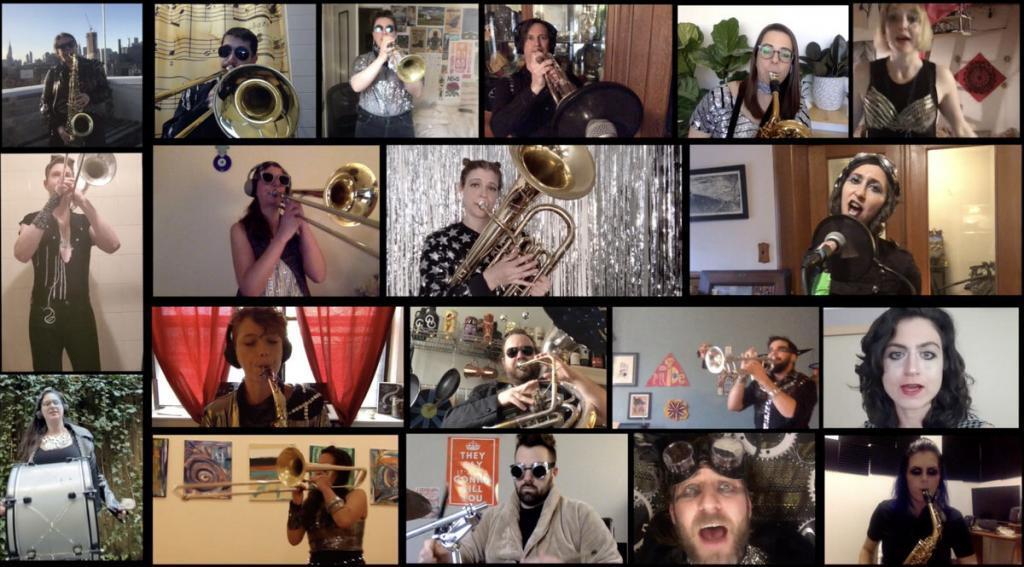In 2020 millions of musicians have experimented in creative ways out of necessity, making new and old technology their instrument. This is especially true in education where playing music together live is essential to the experience, yet many students are left to study at home with limited in-person interaction with other students and teachers.
As the son of school teachers and musicians, Trad Jazz was an intimate part of my music education. Some traditions die hard for good reason, such as the countless standard tunes in the Jazz canon. A lot of songs have lasted over a hundred years, but every song added to that repertoire is a slight progression. Collective improvisation leads naturally to evolution, even as generations have attempted to adhere to tradition.
Unquestionably technology has extended the potential of music to reach fans. With increased bandwidth comes more bands utilizing that bandwidth, and educators need to answer hard questions about balancing traditional rehearsal with independent study.
2020 demanded teachers and students learn the new tools of the trade as well as the old. Fortunately for teachers, students can help in the technology department, but this first requires providing the necessary tools, like guaranteed reliable internet for everyone. Latency-free remote jamming now exists thanks to researchers like UC Davis trombone teacher Michael Dessen, but creating an effective live stream for music is complicated especially while trying to teach or learn an instrument on camera.
If you are up to the challenge, here are a few things you’ll need to know about playing, rehearsing and teaching music digitally:
Not all lessons require streaming. Band rooms typically have sheet music libraries that need organizing, printing, or digitizing. Practicing the task of cataloguing increases music literacy and informs the viewer of copyright and publishing information. With common tools teachers can dive into music catalogues from a distance, communicate what excites them about music to students, and young people will very naturally use their gadgets to make technology work for everyone.
Live streaming a rehearsal however is similar to playing with other musicians on the other side of the Grand Canyon. Broadcast latency effectively prevents musicians from jamming together remotely. There are recent improvements to this, but it requires computer savvy and better-than-average internet speeds. (JackTrip is one tool developing on GitHub). Keep in mind a better quality stream requires more investment of time, money and internet speed. You get what you put into it, as my old band director would say.

If streaming quality is important to you or if you want to record in high fidelity, you can cost-effectively build a music studio to suit your needs. You’re probably in this category if you’ve ever connected speakers to an amplifier. Recording music digitally mimics (and in fact uses) analog signals going through an Analog/Digital (A-D/D-A) interface, made by companies like AVID, Focusrite, Presonus, etc. They mostly range from two individual preamp input/output channels upwards to your creative limit.
There’s also a wealth of knowledge to be gained working with MIDI (musical instrument digital interface), which you’ll find standard on most keyboards and digital interfaces. MIDI’s benefit is flexibility to play and edit synthesized instruments using very small and quickly transmitted data files.
Certainly music students will benefit from higher fidelity, requiring a minimum of an A/D interface with XLR and 1/4” instrument jacks, microphone(s), and cables as required. Most digital recording hardware comes with a software license for a particular DAW (digital audio workstation, such as Garageband or Studio One), and you can even combine two or more A-D/D-A interfaces if you start running out of channels. A word of caution: most software packages come bundled with a dozen or more software plugins. I’d recommend downloading only programs from the device manufacturer, due to compatibility issues and to avoid getting on 10 companies’ overzealous marketing lists.
If you’ve made it this far, we’re not done yet. Before purchasing gear, verify your computer is equipped with enough RAM (2GB min.), processing power (1.5GHz min.), a compatible operating system (Windows/Mac) and correct cable inputs to run the hardware/software package. For live streaming in high-fidelity it is recommended to have a hard wired connection to the computer via Ethernet.
If live streaming technology is over a teacher’s head, that’s okay! Not forgetting public school facilities left unused, there will come a time when studying and rehearsing in person universally resumes.
Speaking from 30 years experience in the music business, the airwaves are full of more music than ever. Bands large and small are able to play to audiences spread over thousands of miles, and demand has increased a hundred fold for technology enabling us to play together and teach remotely. Without the initial opportunity to practice in the same room students have a challenge ahead of them, but those seeking a challenge equally complex as playing an instrument will find it rewarding.
David Hull, Piano Entertainer, AFM Local 174-496/ +1 (504) 881-3345 FunkNoise.com, ProhibitionRecords.org, Patreon.com/ProhibitionRecords, Facebook.com/PreservationHull Facebook.com/ProhibitionRex, YouTube.com/DehaMusicCo, Twitter.com/DehaMusicCo, Instagram.com/FunkNoise






















